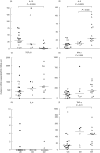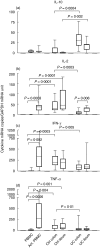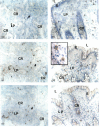Over-expression of interleukin 10 in mucosal T cells of patients with active ulcerative colitis
- PMID: 12974765
- PMCID: PMC1808826
- DOI: 10.1046/j.1365-2249.2003.02268.x
Over-expression of interleukin 10 in mucosal T cells of patients with active ulcerative colitis
Abstract
Ulcerative colitis (UC), a chronic inflammatory bowel disease, exhibits pronounced increase of T lymphocytes in the inflamed mucosa. To understand the role of intestinal T lymphocytes in the pathogenesis of UC their cytokine production in the mucosa was analysed. Intestinal T lymphocytes of UC, Crohn's disease and control patients were analysed for cytokine mRNA levels by real-time quantitative reverse transcription-polymerase chain reaction (RT-PCR) directly after isolation without in vitro stimulation. Frequencies of cytokine positive cells were determined in UC and control colon by immunomorphometry. T lymphocytes in normal colon expressed interleukin (IL)-2, interferon (IFN)-gamma, tumour necrosis factor (TNF)-alpha and transforming growth factor (TGF)-beta1, but not IL-4, IL-5 or IL-10. In UC, a highly significant increase in IL-10 mRNA levels in T lymphocytes and an increased frequency of IL-10 positive cells was seen in colon. IL-10 mRNA levels were also elevated in T lymphocytes of the non-inflamed ileum and correlated with disease activity at both locations. CD4+ T lymphocytes were the major source of IL-10 mRNA. IL-2, IFN-gamma and TNF-alpha mRNA levels were decreased in colonic T lymphocytes, and virtually no IL-2, IFN-gamma, TNF-alpha or TGF-beta positive cells were detected in basal lymphoid aggregates. However, scattered IL-10 positive cells were found here. Lamina propria outside the aggregates contained IL-10-, IFN-gamma, TNF-alpha and TGF-beta but not IL-2 positive cells. T cells of UC patients did not express IL-4 or IL-5. Taken, together the data suggest a generalized activation of IL-10 producing CD4+ T cells along the intestine of UC patients. The local environment seems to determine the biological consequences of elevated IL-10.
Figures






Similar articles
-
Cytokine mRNA expression in intestinal tissue of interleukin-2 deficient mice with bowel inflammation.Gut. 1997 Dec;41(6):793-800. doi: 10.1136/gut.41.6.793. Gut. 1997. PMID: 9462212 Free PMC article.
-
Tissue levels of tumor necrosis factor-alpha correlates with grade of inflammation in untreated ulcerative colitis.Scand J Gastroenterol. 2007 Nov;42(11):1312-20. doi: 10.1080/00365520701409035. Scand J Gastroenterol. 2007. PMID: 17852866
-
Intraepithelial lymphocytes in human gut have lytic potential and a cytokine profile that suggest T helper 1 and cytotoxic functions.J Immunol. 1996 Sep 1;157(5):1926-34. J Immunol. 1996. PMID: 8757311
-
Reciprocal IFN-gamma and TGF-beta responses regulate the occurrence of mucosal inflammation.Immunol Today. 1997 Feb;18(2):61-4. doi: 10.1016/s0167-5699(97)01000-1. Immunol Today. 1997. PMID: 9057354 Review.
-
Selective immunomodulation in patients with inflammatory bowel disease--future therapy or reality?Neth J Med. 1996 Feb;48(2):64-7. doi: 10.1016/0300-2977(95)00091-7. Neth J Med. 1996. PMID: 8819802 Review.
Cited by
-
Molecular mechanism of interleukin-2-induced mucosal homeostasis.Am J Physiol Cell Physiol. 2012 Mar 1;302(5):C735-47. doi: 10.1152/ajpcell.00316.2011. Epub 2011 Nov 23. Am J Physiol Cell Physiol. 2012. PMID: 22116305 Free PMC article.
-
Orofacial clefts lead to increased pro-inflammatory cytokine levels on neonatal oral mucosa.Front Immunol. 2022 Nov 16;13:1044249. doi: 10.3389/fimmu.2022.1044249. eCollection 2022. Front Immunol. 2022. PMID: 36466891 Free PMC article.
-
Activation of Resolution Pathways to Prevent and Fight Chronic Inflammation: Lessons From Asthma and Inflammatory Bowel Disease.Front Immunol. 2019 Jul 23;10:1699. doi: 10.3389/fimmu.2019.01699. eCollection 2019. Front Immunol. 2019. PMID: 31396220 Free PMC article. Review.
-
Geniposide promotes splenic Treg differentiation to alleviate colonic inflammation and intestinal barrier injury in ulcerative colitis mice.Bioengineered. 2022 Jun;13(6):14616-14631. doi: 10.1080/21655979.2022.2092678. Bioengineered. 2022. PMID: 36694912 Free PMC article.
-
High-altitude hypoxia exacerbates dextran sulfate sodium (DSS)-induced colitis by upregulating Th1 and Th17 lymphocytes.Bioengineered. 2021 Dec;12(1):7985-7994. doi: 10.1080/21655979.2021.1975017. Bioengineered. 2021. PMID: 34666625 Free PMC article.
References
-
- Fiocchi C. Inflammatory bowel disease. Etiol Pathogen Gastroenterol. 1998;115:182–505. - PubMed
-
- Halstensen TS, Mollnes TE, Garred P, Fausa O, Brandtzaeg P. Epithelial deposition of immunoglobulin G1 and activated complement (C3b and terminal complement complex) in ulcerative colitis. Gastroenterology. 1990;98:1264–71. - PubMed
-
- Kozarek RA. Review article: immunosuppressive therapy for inflammatory bowel disease. Aliment Pharmacol Ther. 1993;7:117–23. - PubMed
-
- Boismenu R, Chen Y. Insights from mouse models of colitis. J Leukoc Biol. 2000;67:267–78. - PubMed
-
- Powrie F, Leach MW, Mauze S, Caddle LB, Coffman RL. Phenotypically distinct subsets of CD4+ T cells induce or protect from chronic intestinal inflammation in C.B-17 Scid mice. Int Immunol. 1993;11:1461–71. - PubMed
Publication types
MeSH terms
Substances
LinkOut - more resources
Full Text Sources
Other Literature Sources
Medical
Research Materials

